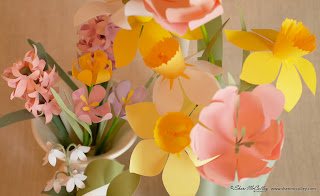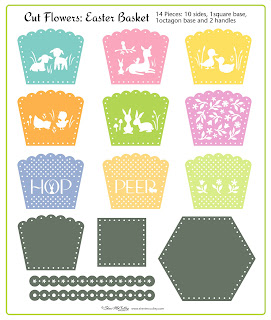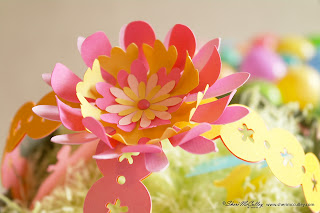It isn’t Easter time without daffodils, tulips and of course Easter lilies. I have a way for you to force these bulbs to bloom right now and become a beautiful bouquet in time for Easter Sunday.
I have created another set of Cut Flowers files for Lettering Delights, this time for the Easter ~ Spring season. This complete set comes with daffodils, tulips, Easter lilies, hyacinths, crocuses and lily of the valley flowers. You can see the complete set of the flowers in the diagram below and tutorials for each type of flower to help in making your own bouquet.
To make the tulip flowers use the tulip petals and leaves (I chose to have two petal sets). Cut out the petals on text weight paper, bend into cup shape by using dull scissors (or I use a bamboo skewer) to gently bend the individual petals into shape (both inward and outward at the ends). Then thread over painted or dyed bamboo skewer that becomes the stem for the tulip (using the center hole that is in the middle of the petal pieces). Next, make the stamen (once it is cut out of text paper) by twisting it tightly around the skewer and gluing it over the pointed end of the tip of the skewer (after you have positions the petals as you like them). Cut out the leaves and glue them (use tacky or white glue) onto the green skewer stem to complete the flower. For the tulip and the daffodil flowers I used a 10 or 12 inch skewer for the stem.
To make the daffodil flowers cut out all pieces of the flower using text weight paper in appropriate colors. Make the bell/cone of the flower by gently bending (rolling) the piece into a trumpet or bell shape and glue the ends of the rolled piece together. Bend the main petal flower downward with the skewer or dull scissors and then glue the bell/cone shape to the main petals (matching up the pointed tips of the cone to the center of each petal. (see white daffodil in photo above). Next, make the stamen by twisting it tightly around the skewer and gluing it over the pointed end of the tip of the skewer (after you have positions the petals as you like them). Cut out the leaves and glue them onto the green skewer stem to complete the flower.
To make the Easter lily flowers cut out all pieces of the flower using text weight paper in appropriate colors. Make the trumpet of the lily by gently bending (rolling) the piece into a cone shape. Bend the ends of each petal flower outward with the skewer or dull scissors and then glue the ends of the trumpet shape together. Next, make the stamen by twisting it gently around the skewer and gluing then individual stamen piece with the others. As the stem for this flower I used thick florist green cloth wire so the lily would bend out from it. I used a glue gun to attach the trumpet and stamen (tucked inside the trumpet to the end of the wire and then also glues leaves down the wire. You could also use a skewer for the stem, but I think a bend in the stem is nice for this type of flower and a wire looks better.
To make the crocus flowers use the same instructions and technique as described for the tulip, with the exception of bending the petals inward and not back outward. Also, to make the leaves for this flower twist them tightly around the skewer and glue near the base of the painted or dyes green skewer that becomes the stem. For this flower I used a six or eight inch skewer.
To make the hyacinth flowers cut out many star shaped petals from text weight paper to have enough for a full flower. Then shape each petal by bending it into shape with the skewer (bending the petals away from the center outwardly). Once there are enough petals, glue them onto a dyed (or painted) wooden dowel with a glue gun, about a .25-.375 inch dowel and about 6-8 inched long, positioning them around the dowel. Then glue the leaves quite far down onto the dowel-stem to complete the flower.
To make the lily of the valley flowers cut out many of the little white star shaped petals from text weight paper. Once cut, shape each flower with the skewer, bending inward and outward each petal. I chose to use green cloth florist wire to hang the flowers from and glue gunned each white flower onto the curved end of the wire. I then glued all of the wired flowers together with the glue gun and covered up the wire cluster with the large lily of the valley leaves. There is a stem shape in the file that can be used for the little white lilies to hang from, but you will need to use thick paper if you are using that stem and glue each flower shape to it.
To make this lovely spring bouquet in time for Easter, go to Lettering Delights and you will find the Cut Flowers Easter set to choose this set and many others for your Easter and spring celebrations. Have a happy Easter this year!


































































